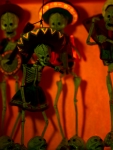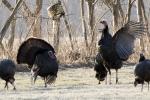Reply to comment
Warning: Adult Spider Content
ktuli — Thu, 05/26/2011 - 20:59
OK - I'll be honest, I originally had a nice calm (I'd go so far as to call it "dreamy" even) flower photo all set to share for today, but then I realized that this is my 200th post, and since I did a spider post for my 100th post, I figured I'd stick with it and share this set for my 200th. My apologies in advance to those of you who don't like spiders, I promise to share that flower photo tomorrow to make up for it.
Anyway.... our front yard is surrounded by a lot of ground vines and hostas and other low plants like that, and this time of year, they get carpeted with spiderwebs. I'm not entirely certain of the exact species (it might be Frontinella communis, but I really need to buy a good spider identification guide), but I think it is some species of sheet web. Regardless, one of the interesting things about them is that the male and female live together in the web for several days to a couple weeks.
I've tried many times in the past to photograph them, and it rarely turns out well. They are usually in hard to reach locations, making tripod use difficult, and I often have to avoid crushing Anya's flowers and plants. Their webs are extremely chaotic - not like a nice clean orb weaver web which is flat and exists on a single plane, these webs are random and usually several inches thick and that causes them to catch the light from multiple angles. And they're rather small too - probably in the range of 1/4".
But this year I was determined to try again... Ok I think I blabbered enough to get the photos off the top of the screen for those of you who dislike spiders.
Warning: The following contains adult spider content. Viewer discretion is advised.
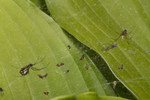 |
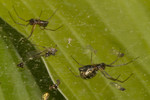 |
 |
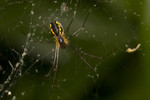 |
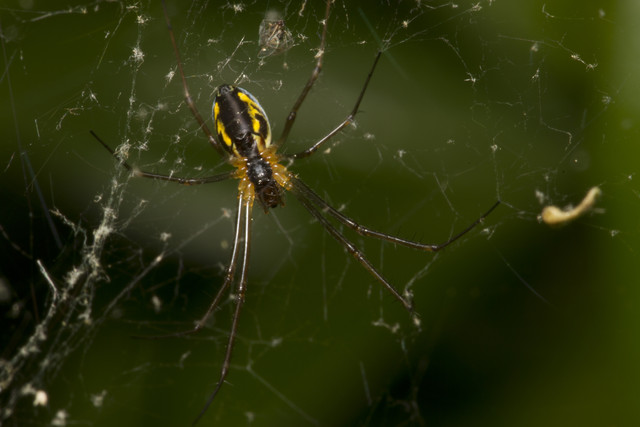 | |||
 |
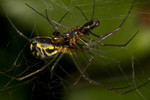 |
 |
 |
Technical Data: Canon EOS 7D, Canon EF 100mm f/2.8L Macro IS USM, 1/160, 1/200, or 1/250 sec at f/16. Canon Speedlight 580EX II flash in auto mode and wireless control. Image Stabilization on. ISO 160. RAW processing in Adobe Camera Raw. Last three photos with Kenko Teleplus PRO 300 "DG" AF 2x Teleconverter.
So, the top row of photos all basically just show the spiders. The female is the slightly larger one with the yellow stripes along her abdomen. In the first couple shots, you can see just how effective they've been at trapping various bugs, and can see how they are coexisting with each other in the same web peacefully.
The bottom row of photos all depict their mating behavior. The male would drum on the females abdomen with his pedipalps (the short "arms" by his head - in this species they look like they have large brown boxing gloves on them). After that he would either inflate an organ there or secrete a yellowish liquid (I'm honestly not sure which it was), and then pass a sperm packet to the female (the organ would deflate or the yellowish liquid would be absorbed into the female). This went on literally for hours. I stopped back repeatedly hoping to get a photo of the final act... which is the female eating the male after they have finished mating. Unfortunately, I never managed to get that shot.
But I thought capturing the mating behavior of such a tiny little spider was kind of interesting. Since then, I've noticed at least three other pairs of spiders mating as well, and every time I do, the next morning that web is inhabited by only the female. The poor guys have it rough! Then again, the females will hold on to those sperm packets for some amount of time until they're ready to lay eggs, and then fertilize probably several hundred eggs at once. Perhaps having several hundred babies to contend with is why the males willingly let themselves be eaten after mating...
Sorry if the spider photos gave you the heebie-jeebies, but thanks for stopping by for my 200th post. Leave me a comment and let me know what you think of these shots. And I promise I'll share a nice calm flower photo with no adult content tomorrow...
- Bill


